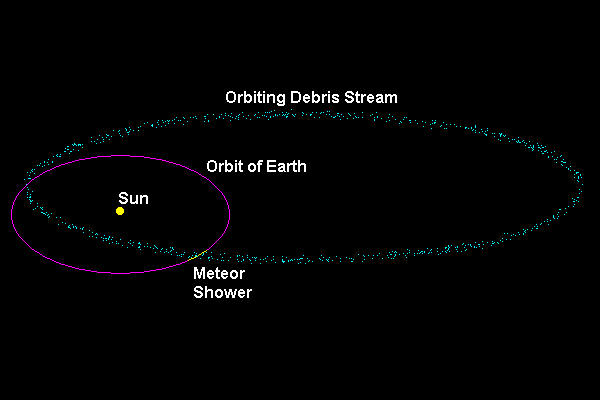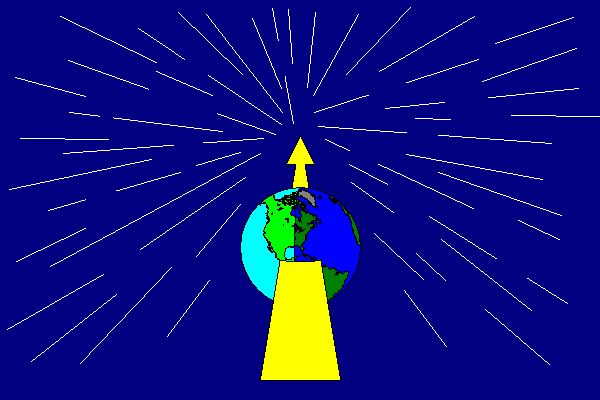Meteors and Meteorites
Steven Dutch, Professor Emeritus, Natural and Applied Sciences, Universityof Wisconsin - Green Bay
Basic Terms
- Meteoroid
- Any small object in orbit around the Sun
- Meteor
- A meteoroid that becomes visible because of frictional heating by the earth's atmosphere.
- Bolide or Fireball
- An exceptionally brilliant meteor. In impact geologythe term "bolide" is often used to mean a meteoroid big enough to penetrate the atmosphere and strike with force.
- Meteorite
- Any meteoroid that survives passage through the atmosphere and reachesthe surface of the earth.
- Micrometeorite
- A microscopic meteoroid. They are slowed gradually by friction in the upper atmosphere and do not become visible. In space, however, they are moving many kilometers per second and can dig tiny craters in whatever they hit.
Meteors
Meteors come from two sources. Sporadic meteors are just random bits of space debris that collide with the earth. They can hit any time, any place. Meteor showers are predictable bursts of meteor activity that occur when the earth intersects a stream of orbiting debris, generally from a comet.
Daylight Meteors
Occasionally, exceptionally bright meteors are visible in broad daylight. One of the most celebrated was a meteor that nearly hit the earth on August 10, 1972. The object, about the size of a bus, entered the atmosphere over Utah and first became visible at an altitude of 76 kilometers. It traveled nearly due north, reaching a minimum altitude of 58 kilometers over southwestern Montana, then exited the Earth's atmosphere near Calgary, Alberta. Heated by its passage, it faded from visibility at an altitude of 102 kilometers. Although the meteor was visible a total of 101 seconds, was visible at any one spot for less than 30 seconds, passed over a sparsely inhabited region and was completely unexpected, we nevertheless have dozens of clear photographs of the event (admittedly, it passed close to Grand Teton and Yellowstone National Parks, where there would have been a large number of cameras within easy reach). One video was shot by a woman who tracked the object so precisely that when it reappeared from behind some clouds, it was still perfectly centered in the frame. An observer in Canada photographed the object exiting back into space. A complete report is in the July, 1974 issue of Sky and Telescope.
Faint daylight meteors can be detected by radio. The meteor creates a trail of ionized gas that reflects distant radio signals for a few seconds. Daylight meteor hunters tune to a frequency not used in the area and listen for short bursts of distant signals. There are a number of daytime meteor showers known. Curiously, the most intense all cluster around the month of June.
Meteor Showers

Meteor showers occur when the earth crosses a stream of orbiting debris, usually from a comet. The dust shed by a comet's tail continues to orbit the Sun, and because the particles all have slightly different velocities, they end up spread all around the orbit. Depending on the geometry, the Earth may or may not intersect the stream twice. Since the orbits of the debris in any stream are all very similar, meteors from different showers hit the Earth at predictable speeds, ranging from a low of 14 km/sec for showers that overtake us from behind to 70 km/sec for those that hit us head-on. The meteors are all tiny, as shown by the fact that no meteorite has ever been observed to fall from a meteor shower.
About 70 meteor showers are known. The parent bodies of some have been identified. The Orionids, which peak in October, are debris from Halley's Comet, for example.

As Earth plows into the debris stream, the meteors appear to radiate from a point in the sky. This is purely a perspective effect, like driving into a snowstorm. The point where the meteors appear to originate is called the radiant. Meteor showers are named for the constellation where their radiant is located. The location of the radiant is determined by the relative motions of both the earth and the meteors.
Note that, in the diagram above, the sunset terminator is on the trailing side of the Earth. The sunrise side of the Earth is the leading side, so meteor rates, both shower and sporadic, are greatest before dawn.
Meteor showers as hyped in the media tend to be disappointing. A really good meteor shower might have 100 meteors per hour, or about one every thirty seconds, except any one observer can only see a fraction of the sky at once, so under really good conditions one might see a meteor every couple of minutes. However....
Once in a while, the earth hits an unusually dense patch of debris, and the rate can jump to thousands per hour, or several per second. The Leonids, which peak in November, are especially noted for meteor storms. In 1799, 1833 and 1866 there were storms that caused widespread fear, and there were dramatic but shorter storms in 1966 and 1999. Other showers have produced storms as well. The normally mediocre Draconid shower of early October produced spectacular storms in 1933 and 1946.
Meteorites
There are three basic classes of meteorites: stony, stony-iron and iron. When meteorites are recovered after being observed to fall, stony meteorites make up 95%, stony-irons 1% and irons 4%. Meteorites discovered without being observed to fall are more dominated by irons, simply because irons are much easier to distinguish from terrestrial rocks. Irons make up about 15% of these meteorites. Meteorites observed to fall are called falls, those discovered without being observed to fall are called finds.
Did it Fall?
People who see a bright meteor are often convinced it fell "just over the hill." After enough instances of chasing three states' worth of "just over the hill," meteorite hunters disregard such accounts. A meteor the size of a marble will be dazzling. The only times it is worth hunting for a fallen meteorite at all are:
- Somebody saw or heard it hit.
- It made an audible sound (explosion, sonic boom, etc.)
- Of course, if actual fragments are found, it's worth searching for more.
Stony Meteorites
Most of the stony meteorites are chondrites, made of iron and magnesium silicates with a pellet-like texture. The pellets, called chondrules, are considered to be the primordial particles that condensed out of the solar gas cloud and later accreted into larger bodies. One class, calledcarbonaceous chondrites, are the closest known match to the composition of the Sun (minus elements that remained as gases) and are thus considered to be the most primitive materials in the Solar System. Carbonaceous chondrites are basic planetary raw materials.
Achondrites are silica poor igneous rocks that have a more or less uniform texture. Most are basalt, others are the coarse grained equivalent, called gabbro, that cooled in the interior of some parent body. They are known to have originated on the Moon, Mars, and some asteroids, including the large asteroid Vesta.
Stony-Iron Meteorites
There are two types of these rather rare meteorites. Mesosiderites are mixtures of iron fragments and shattered silicate minerals, and are thought to have resulted from the collision of iron and stony parent bodies. Pallasites are iron with inclusions of silicate minerals and are believed to be fragments of the core-mantle boundary of some parent body that was large enough to have begun forming an iron core.
Iron Meteorites
Iron meteorites consist of iron and nickel. At high temperatures, the iron and nickel mix freely, but as the original parent body cooled, the iron and nickel separate into two distinct materials. Kamacite is iron rich with only a few per cent nickel, and taenite is nickel rich, with 25% nickel or more. Etching the meteorites with a mixture of nitric acid and alcohol brings out a distinctive texture found only in iron meteorites.
Tektites
Tektites are green or black glassy blobs with streamlined shapes found in broadly scattered areas called strewnfields. For a long time they were controversial, with various theories advocating volcanic or impact formation, and terrestrial or lunar origins. They are now generally accepted as of terrestrial impact origin, created when the impact melted terrestrial target rocks. The major strewnfields are:
- Ivory Coast
- Connected to the Lake Bosumtwi impact, one million years old.
- Central Europe
- These are chiefly found in the Czech Republic and are known as moldavites. They are connected to the Ries Basin impact in Germany, 15 million years old,
- North America
- Found in Georgia and Texas, with one stray from Massachusetts. Connected to the Chesapeake Bay Impact, 34 million years old.
- Southeast Asia-Australia or Australasian
- The largest strewnfield on earth, in both area and quantity of tektites, is the only one with no known impact crater. Candidate impact sites include beneath the Antarctic ice cap, or in the Bengal submarine fan in the Bay of Bengal. The tektites are 800,000 years old.
Improved understanding of impact physics solved the tektite problem. One former objection to a terrestrial impact origin was that air resistance would prevent tektites from flying large distances. But we now understand that a large impact creates a shock wave that essentially pushes the atmosphere aside, allowing the tektites to be launched to the fringes of space and beyond.
Many other impact sites produced tiny glass spherules from the condensation of vaporized rock. These are called microtektites.
Known tektites are all very young. There must have been many other impact events in geologic history that produced them. However, glass hydrates and recrystallizes quickly in geologic terms.
Zodiacal Dust
Large quantities of micrometeoroids orbit in and near the plane of the ecliptic. They are constantly created by tiny impacts, and spiral into the Sun within a few thousand to a few million years.
The reason is that very tiny particles are struck obliquely by sunlight, just like someone walking in the rain feels the raindrops coming in at a slant. Thus sunlight slows these particles down and causes them to drop in toward the sun.
However, there is a constant supply of tiny particles. They are visible to the unaided eye as a faint cone of light extending from the sun along the ecliptic. This triangle of light is called the zodiacal light, and when it appears before sunrise, it is often called the "false dawn." It actually continues around the ecliptic in a faint band called the zodiacal band, and has a faint brightening directly opposite the Sun called the gegenschein (German: "counter-shine"). Interplanetary dust actually reflects light from all over the sky and contributes a significant part of the night sky light.
The actual amount of dust is very small. According to one calculation, if the dust grains are a millimeter in diameter they could be kilometers apart and still produce the observed light.
Speaking of zodiacal bands, guitarist Brian May of the rock group Queen returned to his graduate studies after a 36-year break, published his thesis research on the zodiacal light, and was awarded his PhD in 2008. Normally 36 years would be long enough to render a thesis hopelessly out of date, but his research topic was not an area of hot research. Asteroid 52665 Brianmay was named in his honor.
Return to Planetary Images Index
Access Course Notes on Planetary Geology
Visit Bibliography and Listing of Impact Sites
Return to Professor Dutch's Home Page
Created 27 October 2008, Last Update 11 January 2020